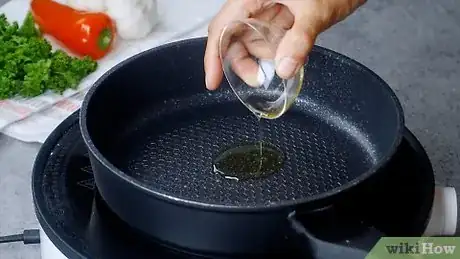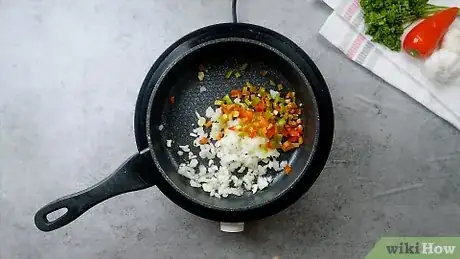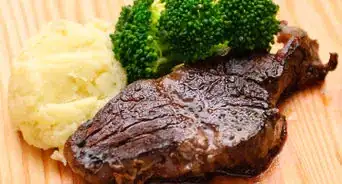wikiHow is a “wiki,” similar to Wikipedia, which means that many of our articles are co-written by multiple authors. To create this article, 14 people, some anonymous, worked to edit and improve it over time.
There are 7 references cited in this article, which can be found at the bottom of the page.
The wikiHow Culinary Team also followed the article's instructions and verified that they work.
This article has been viewed 531,968 times.
Learn more...
Though it sounds gourmet, squid is readily available, inexpensive and surprisingly easy to prepare and cook. If your memories of squid are of lengthy, chewy bites followed by a hard swallow, you should know that there are a variety of ways to cook squid that are far more delicious than rubbery, over-done calamari.
Steps
Cutting and Preparing Whole Squid
-
1Know that whole squid are cheaper and tastier than pre-cut calamari. There are a lot of parts to a squid that are thrown out when a squid is pre-prepared. It may seem gross at first, but prepping a whole squid requires nothing but a sharp knife and a willingness to get your hands dirty.[1]
-
2Pinch between the eyes and body and pull the head out of the mantle. This is probably the grossest part of the whole process, and you get it done first. Hold the squid firmly by the body, or mantle. Squeeze gently above the eyes and pull towards the tentacles so that you have two parts -- the head and tentacles and the mantle.
- This may get messy, so do it over the sink when possible.[2]
Advertisement -
3Chop the head off the tentacles by cutting beneath the eyes. Discard the eyes and head, keeping the tentacles for later. If you want to save the ink, which is great in stews or pasta, it is attached above the head and is a silvery sack with black liquid inside. Cut it away and drain the ink into a bowl to use later. Be sure to be careful in this step so you do not lose the ink or stain your clothes or furniture. [3]
-
4Remove the beak from the tentacles by pinching it out from the center. The hard mouth of the squid sits in the middle of the tentacle cluster. Feel around for a small, seed like beak at the base of the tentacles. It can be popped out by squeezing out in the direction of the tentacles.
- Cut any extra long tentacles back so that they are all roughly even length and then set the tentacles aside-- they are ready to cook and serve.
-
5Pull off the two fins. You can trim them back with a knife as well, but pulling them off will weaken the skin, which you need to remove later. Pull back the fins (they look like wings on the body) then pinch them with your thumb and forefinger until have a good grip. You can then easily pull them off the body of the squid.
-
6Pull out the hard piece of cartilage, or quill from inside the body of the squid. You should be able to feel it easily in the mantle of the squid along the belly, and it will slide out easily. It may break inside the squid, so make sure to feel for any hard bits before you begin cooking.
-
7Use the back of your knife to squeeze any remaining viscera out of the squid body. Starting at the tip, use the back of your knife to push the remaining gunk out of the mantle. If you're feeling adventurous, it is often easier to just reach in with your hands or a spoon and simply scoop it all out.[4]
-
8Remove the membrane. The membrane is the gel-like, purple skin covering the squid. Cut the tip off the mantle and use it to get some skin loose, then pull it away. If you are having trouble, scrape the blade of the knife at an angle along the skin, almost like you were gently whittling. Rinse the squid in cold water when you're done.
-
9Cut the mantle into your desired shape. If you want calamari, cut the mantle horizontally so that you have rings of squid. For most other servings, cut along one edge of the squid to open it up into a flat piece and then cut into squares.
- You can also score the fish for faster cooking. Make small slices halfway into the flesh with your knife at an angle so that the squid is ridged.[5]
Cooking Calamari
-
1Pat your rings of squid dry with a paper towel. Calamari requires thin rings of squid. If you start with the body of the squid, simply pat it dry and then cut horizontally across the body with a sharp knife -- turning the tube of seafood into 1/2" rings for cooking.
- 1 lb of fresh squid usually equals 1/2 lb of calamari, which is generally enough for one person.
-
2Consider soaking the rings in a buttermilk bath for tenderness and richer flavor. This will make a heavenly fried calamari, but you can skip the step if you don't have time. To make your own buttermilk mixture, if you don't have any handy:
- Mix 2 cups of milk with the juice of one large lemon. You can also add a dash of hot sauce too for flavor.
- Let the mixture sit for 4-5 minutes. You should see it thickening.
- Soak the calamari rings in the buttermilk mixture for 3-4 hours before moving on. When ready, remove the rings and drain any excess liquid.[6]
-
3Mix 2 cups of flour, 1 teaspoon salt, and 1 teaspoon pepper in a medium sized bowl. You can also add any other spices you desire, such as a teaspoon of paprika, chili powder, or cayenne. Whisk together well.
-
4Coat the rings of calamari in the flour mixture. Coat the rings so that each of them is completely covered in flower. You may need to work in small batches, and you'll likely need to add more flour if you start running out.
-
5Heat up 1/2" oil to medium-high heat on the stove top. You may need 1-2 cups of vegetable oil in order to have enough, as it should almost coat the rings when they cook. If you have a thermometer, get the oil up to 360℉. You can also use a deep-fryer set to 360℉. If you don't have a thermometer, wait until the oil is shimmering throughout.
-
6Cook the calamari in small batches until golden brown, about 2-3 minutes. Flip the rings once as they cook, removing them when the flesh underneath the breading is no longer shiny or translucent. Make sure you don't crowd the pan, adding only enough pieces to fill the bottom without touching or overlapping. Adding too much will drastically lower the temperature of the oil, leading to greasy, unappealing calamari.
- If you want crispier calamari with a smoother inside, heat the oil to 400℉ and cook the squid for no more than a minute or a minute and a half.
Pan-Frying Squid
-
1Pan fry cut squid with some seasonings for a quick, delicious meal or appetizer. Squid only needs to cook for 30-45 seconds, and it's tender, mild flavor works with a variety of spices. Start with cleaned tentacles and the body of the squid flattened and cut into 1-2" squares.
-
2Heat up 1/2 tablespoon of oil in a pan on medium-high heat. You want the oil to be hot so that the squid cooks quickly. Leaving the meat in the oil for too long will make it tough and rubbery.
-
3Cook any aromatics in the oil for 1-2 minutes. Aromatics are simply small vegetables and herbs that soften under heat and are used in cuisines worldwide. Toss them in the hot oil and give them a few minutes to get tender before moving on. Some good ideas (listed per squid being cooked) include:
- 1-2 clove garlic, minced.
- 1/4 cup diced white onions.
- 1/3 cup diced chili peppers.[7]
-
4Add a small batch of squid and cook for 30 seconds. You do not want to fill the pan, or you'll lower the temperature too fast and ruin the cooking process. Put enough pieces in so that they have room to move and stir frequently. If you have a large sauce-pan, 1 whole squid should be perfect.
-
5Add any seasonings and toss for another 10-25 seconds before removing. You only want the squid to cook until it is white and no longer translucent (partially see-through). Then, add your spices and mix everything up well before serving immediately. You can mix it into pasta or simply eat it as is. Try out:
- 1 tablespoons of soy sauce and a handful of chopped coriander
- A pinch of salt, black pepper, and lemon juice to taste.
- Salt, black pepper, and the squid's own ink.
Community Q&A
-
QuestionWill the squid slip when I cut it?
 Community AnswerNot if you dry it first. Dry the squid off with a paper towel after cleaning, cut, then season.
Community AnswerNot if you dry it first. Dry the squid off with a paper towel after cleaning, cut, then season. -
QuestionHow do I make the meat of the squid soft and juicy when I put it in boiling water?
 Community AnswerBoiling it will not make it soft and juicy. Squid, in general, has a tougher consistency. Like most seafood, it should be cooked quickly. So, if you are cooking it in a soup, it should be added at the very end of the cooking process, shortly before serving. Otherwise, it should be marinated and grilled or breaded and fried.
Community AnswerBoiling it will not make it soft and juicy. Squid, in general, has a tougher consistency. Like most seafood, it should be cooked quickly. So, if you are cooking it in a soup, it should be added at the very end of the cooking process, shortly before serving. Otherwise, it should be marinated and grilled or breaded and fried. -
QuestionHow can I keep the oil from exploding when I cook squid?
 Community AnswerMake sure your squid is dry. You can use a paper towel to dry them. Also, they will be dry if you used seafood seasoning.
Community AnswerMake sure your squid is dry. You can use a paper towel to dry them. Also, they will be dry if you used seafood seasoning.
Warnings
- Squid are slippery, so be careful when you're cutting it. Always cut away from your body, not towards.⧼thumbs_response⧽
References
- ↑ http://www.seriouseats.com/2010/07/how-to-clean-whole-fresh-squid-instructions.html
- ↑ http://www.seriouseats.com/2010/07/how-to-clean-whole-fresh-squid-instructions-slideshow.html#show-98123
- ↑ http://www.bbc.co.uk/food/recipes/squidwithmintchillic_90292
- ↑ http://food52.com/blog/7003-how-to-clean-squid
- ↑ http://www.bbcgoodfood.com/technique/how-prepare-squid
- ↑ http://www.cookingchanneltv.com/recipes/chuck-hughes/fried-calamari.html
- ↑ http://www.bbcgoodfood.com/technique/how-prepare-squid
- http://www.marthastewart.com/article/calamari-101
About This Article
To cook squid, start by heating 1/2 a tablespoon of oil in a pan over medium-high heat. Then, add chopped pieces of squid to the pan and let it cook for 30 seconds. After 30 seconds, add any seasonings you'd like to use and let the squid cook for 25 more seconds before removing it from the heat. If you want to make fried calamari, heat 1-2 cups of oil in a pan over medium-high heat and cook the squid in it for 2-3 minutes. To learn how to cut and prepare squid for cooking, read on!























































